DEVIATION REPORT: ISSUE 1, OCTOBER 2020
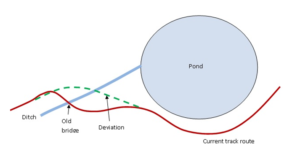
DEVIATION REPORT: ISSUE 1, OCTOBER 2020
All photos of this project can be found in The Deviation Gallery Winter 2020
The Deviation starts at beam 076 with a straight section which includes a 3 meter metal beam spanning the tree roots c urrently lifting beam 078 and then bends away to the right on curves up to 60ft in radius. The ditch is crossed 6 meters to the left of the metal bridge then continues in a straight line until joining the extension at beam 513 via a slight curve. The new route eliminates the reverse curve, bypasses the sharp right hand curve and solves any problems caused by the deteriorating state of the old bridge. The rails are on 23 metal beams giving a total length of 46.5 meters with a fall of only 40mm i.e. level track.
 Initial ground work involved inserting 6 posts along the route using a laser beam to set cross pieces at rail height. Calculations show that the ground either side of the ditch needs digging out to form a shallow cutting. Before the ditch only a small amount of digging is required while the other side is higher with a greater spread.
Initial ground work involved inserting 6 posts along the route using a laser beam to set cross pieces at rail height. Calculations show that the ground either side of the ditch needs digging out to form a shallow cutting. Before the ditch only a small amount of digging is required while the other side is higher with a greater spread.
Four 1.4 meter long thick walled water pipes 560mm in diameter were obtained free of charge and off-loaded by the station. They were moved up to the ditch by inserting a metal bar through the tube and with a four man lift placing each across two of the small passenger trucks to form a bogie train. After some scratching of heads on how to unload them the solution was to hold tight to the trucks and give the pipe a quick push keeping well out of the way as they rolled themselves to their resting place.
 The ground surrounding the ditch has been cleared using a brush cutter and the bottom of the ditch levelled. The first water pipe was pushed over the edge and easily rolled into position within the ditch. The second pipe was not quite aligned properly starting its roll. It bounced up the bank on the far side before dropping back to fit perfectly with its end hard against the end of the first pipe – obviously somebody knew what they were doing. Stone left over from the drainage channels at the entrance gate has been used to pack round the bottom of the pipes and by rocking the pipes back and forth settle some stone underneath. A start has been made to drop rubble down the sides of the pipes initially taken from by the water tank helping to tidy up that area.
The ground surrounding the ditch has been cleared using a brush cutter and the bottom of the ditch levelled. The first water pipe was pushed over the edge and easily rolled into position within the ditch. The second pipe was not quite aligned properly starting its roll. It bounced up the bank on the far side before dropping back to fit perfectly with its end hard against the end of the first pipe – obviously somebody knew what they were doing. Stone left over from the drainage channels at the entrance gate has been used to pack round the bottom of the pipes and by rocking the pipes back and forth settle some stone underneath. A start has been made to drop rubble down the sides of the pipes initially taken from by the water tank helping to tidy up that area.
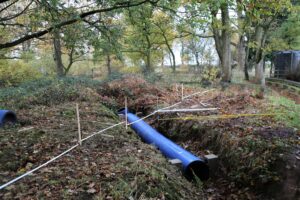
A viable route has been successfully plotted. Marking out is undertaken using an adjustable curve plotting tool with the appropriate radius (straight, 90ft, 70ft, 60ft) set for the curves together with a 2020mm white pipe to set the distance. The tool is laid against two previously inserted posts with the next post, at the end of the tool, being the position of a pillar for the 2 meter metal beam.
The route starts with a 7 meter straight section which cuts through the reverse curve followed by two transition curves set at 90ft then 70ft leading into the 60ft radius curves. The ditch is crossed on a 70ft radius curve with a skew of 45 degrees, the two pillars located either side of the ditch are on unstable ground. Nine beams take the track through the middle of two trees in a straight line before joining the extension.
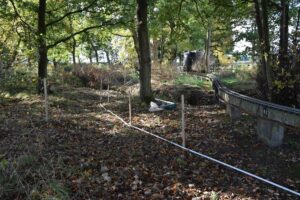
The steel to construct the extra eleven beams required for the deviation has been ordered. Money was authorised to increase the steel order to include the fabrication of a 6 foot jig plus the construction of 2/3 beams. One of these 6 foot metal beams has already been allocated to replace beam 212 on the down line opposite the station which is breaking up. The 6 foot jig is a lasting legacy to the club which will be used in the future
Dave Mulholland and Craig Scarisbrick

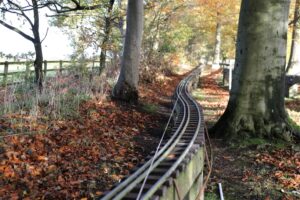 Initial ground work involved inserting 6 posts along the route using a laser beam to set cross pieces at rail height. Calculations show that the ground either side of the ditch needs digging out to form a shallow cutting. Before the ditch only a small amount of digging is required while the other side is higher with a greater spread.
Initial ground work involved inserting 6 posts along the route using a laser beam to set cross pieces at rail height. Calculations show that the ground either side of the ditch needs digging out to form a shallow cutting. Before the ditch only a small amount of digging is required while the other side is higher with a greater spread.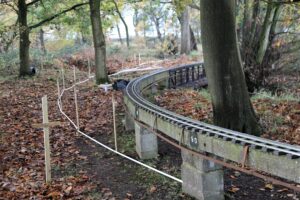 The ground surrounding the ditch has been cleared using a brush cutter and the bottom of the ditch levelled. The first water pipe was pushed over the edge and easily rolled into position within the ditch. The second pipe was not quite aligned properly starting its roll. It bounced up the bank on the far side before dropping back to fit perfectly with its end hard against the end of the first pipe – obviously somebody knew what they were doing. Stone left over from the drainage channels at the entrance gate has been used to pack round the bottom of the pipes and by rocking the pipes back and forth settle some stone underneath. A start has been made to drop rubble down the sides of the pipes initially taken from by the water tank helping to tidy up that area.
The ground surrounding the ditch has been cleared using a brush cutter and the bottom of the ditch levelled. The first water pipe was pushed over the edge and easily rolled into position within the ditch. The second pipe was not quite aligned properly starting its roll. It bounced up the bank on the far side before dropping back to fit perfectly with its end hard against the end of the first pipe – obviously somebody knew what they were doing. Stone left over from the drainage channels at the entrance gate has been used to pack round the bottom of the pipes and by rocking the pipes back and forth settle some stone underneath. A start has been made to drop rubble down the sides of the pipes initially taken from by the water tank helping to tidy up that area.